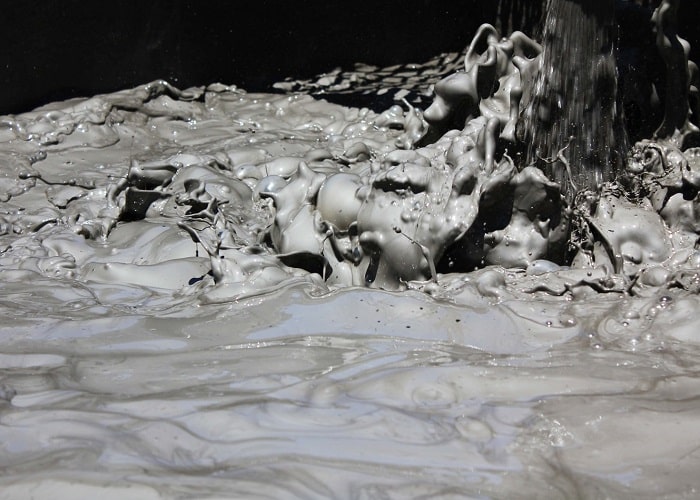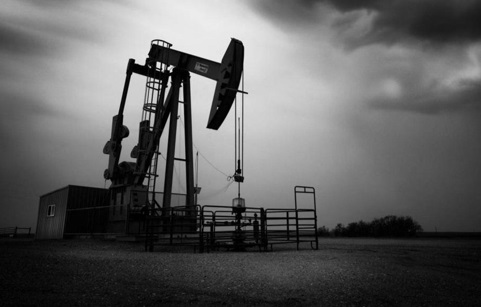Drilling mud is the simplest combination of water and clay. Of course, different types of drilling muds with water and oil bases, etc., and various additives, have different properties and various applications. In general, drilling mud is a thicker liquid than water, which is used in the drilling industry of deep wells.
This mud helps to remove the excavation debris from the bottom of the well and has other functions in the well. If you want to know more about this product; Follow us on Nikan West Gilsonite website and Instagram .
Drilling mud applications
As mentioned; the first and most important application of drilling mud is to remove chips and debris from drilling from the bottom of the well. Drilling mud has a specific property called specific gravity. The higher the specific gravity of the mud, the higher amount of chips extracted from the well will float more easily in it and comes out of the well. However, increasing the specific gravity of the plant reduces the motility of the mud; and it makes drilling harder.

Another application of drilling muds is to maintain well stability. First of all, the pressure of the mud on the wall of the well prevents it from falling. On the other hand, drilling mud has the ability to fill the pores in the well wall and make it impenetrable. The result is an increase in the stability and strength of the well walls.
The third important application of drilling fluid is to prevent the drill from clogging and creating double pressure on it. In fact, drilling muds in the depths of the well and where the drill is working; it prevents the drill from clogging by cooling the drill and removing the chips from around it.
The three main types of this compound are water-dispersible or non-dispersible base mud, oil-based mud and gas mud used to extract natural gas. To prepare drilling mud, a combination of minerals such as bentonite and barite, chemicals such as liquid soda and emulsifiers, and polymeric materials are used. The main functions of these compounds are as follows:
- Removal of wastes while drilling
- Keeping well cool and clean when drilling
- Providing hydrostatic pressure to prevent the well’s wall from collapsing at the outflow of fluids
- The suspension of drilling waste when drilling operations are stopped and equipment is replaced
- both types and functions will be described precisely in the rest of this essay
Types of drilling mud
Drilling fluid has different types, each of which has its own characteristics. In a general classification, drilling fluid consists of two main types: water-based mud and oil-based mud.
In water-based drilling muds, water is the main material to which other mud materials and additives are added. The simplest water-based drilling fluid is water and clay drilling mud.
The second type of drilling fluids are oil-based fluids. These fluids use oil instead of water. Typically, 95 to 98 percent of these fluids are made up of diesel as an oil base.
Read More: “Why is the weight of drilling mud important in drilling?“
Polymer drilling mud, water-based, petroleum, bentonite and synthetic are the types of mud that are used in everyday life. Even in some wells, several types of muds may be used in different parts. The types might be as follow:
- Air: Compressed air is pumped into circular wells.
- Air and water composition: Air is pumped into the well with high pressure along with water to increase concentration, cool the well, and control the soil.
- Water: in some cases, especially in offshore drilling, seawater is used when they are in the early stages of drilling
- Polymer drilling mud: A substance with a special formula called polymer is added to a climate compound that produces foam.
- WBM water-based drilling mud: To prepare this mud, clay or bentonite is added to the water, and other chemicals are added to homogenize the mud. The most common clay used in this method is sodium bentonite, which is gelled in oil wells. This gel is used to prevent the walls from collapsing and to cool the drills.
- Oil drilling mud (oil base) OBM: A type of mud which is produced with petroleum products such as diesel. This combination is used for various purposes such as increasing slipperiness, dandruff incidence and improving well cleanliness without increasing concentration. This type of mud has a higher heat tolerance capacity than other types of drilling mud. In its use, various factors such as cost, environmental considerations and. Are considered.
- SBM synthetic drilling mud: This compound is also called low-toxicity oil drilling mud and is prepared from synthetic oils. It is used in offshore drilling because it has the properties of oil-based mud, but the foam prepared with it is much less toxic.
Functions of Mud
Drilling fluid is used for drilling oil and gas wells and exploration and is also used to strengthen simpler wells such as water wells. There are many types of drilling mud that are needed to be broken down carefully before deciding about it.
Removal of Drilling Waste
Oil and liquids that move outward through drilled wells also carry the scrap waste out of the well. The transport of these wastes depends on their shape, weight and size, and if some of the wastes are large and heavy, they move to the bottom of the well. To prevent this, drilling mud is added to the well so that as the concentration of liquids increases, the contaminants will not be able to go down.
Some types of drilling mud also have thixotropic properties in the sense that their concentration varies under different conditions. as a result:
- Liquids with increasing concentrations are suitable for cleaning wells
- High rotational speed causes waste transfer. In these liquids, the displacement rate must be at least 50%
- High concentrations of liquids can clean the cavity well, even if they do not have a high rotational speed, but may have a negative effect on the internal pressure of the well.
Pressure Control
If the pressure of the well contents increases, the concentration of drilling mud should also be increased in order to maintain the stability of the well walls by creating balance. An imbalance in the pressure of the well contents causes a shock from the fluids and may damage the well wall. The most important substance in muds is barite.
Prevention of Penetration
The columnar pressure of the mud must be greater than the pressure of the so that we can use filters. The mud is designed for filters with low permeability. For structures with high permeability, materials such as calcium carbonate and cellulose are used, which have so-called bridging properties. Depending on the type of drilling mud used, some additives such as clay bentonite, natural or synthetic polymer, natural asphalt and natural gilsonite are added to improve filtration. Sometimes the gilsonite price makes it hard to do such things but in many cases, there are no other ways.
Fixing Wells’ Walls
Drilling mud should be chosen and designed in such a way as to improve the stability of the wells’ wall. The weight of the mud must be balanced within the necessary limits of mechanical stress. The instability of the walls will cause the whole set to weaken, which will narrow the cavity, but the stability of the walls will preserve the size of the cavity and its cylindrical shape. If the well is drilled larger than usual, it will cause weakness and instability, which will result in problems such as ring pressure, inability to clean the well, filling with solids and poor measurement of the system.
Cooling and Lubricating Equipment
Mechanical and hydraulic pressures when the drills are in operation generate heat that must be cooled in some way, otherwise, it will damage the drills, pumps and other equipment. Oily mud usually has better lubricating properties than water-based drilling mud. The amount of lubrication depends on the type of drill and the chemical composition of the system.
Abrasion control
The constant contact and collision of the drills with the stone causes the equipment to corrode. Also, soluble gases such as oxygen, carbon dioxide and hydrogen sulfide, in addition to many risks to the health of employees, also have catastrophic losses for the system. Decreased pH and acidification of the environment is another harmful factor in this industry that can be minimized by the use of drilling mud.
Other Benefits
Other advantages of using drilling mud in drilling oil, gas and water wells include the transfer of hydraulic energy to equipment, ensuring accurate drilling assessment, facilitating cementation of wells and reducing harmful environmental impacts.
Different types and purpose of drilling mud are the main reasons that drilling muds has become really popular and can be seen as one of the most important available materials.
Drilling fluid additives
Different additives give different properties to drilling fluids. The specific gravity of the mud, the amount of viscosity, the degree of hardness, the ability to cover the pores of the wall, etc., are all features that are created by various additives in drilling fluids.

Among the most important additives for drilling fluids are the following materials:
Calcium is one of the drilling fluids additives that increases the hardness of the fluid.
Clay is the most popular additive for drilling fluid. The most important function of clay is to increase the viscosity of the drilling fluid.
Barite is another additive that is often added to drilling fluid by applying a special weight gain to the mud. Weight gain will result in larger chips and lumps coming out of the well.
Bentonite is another material that is widely used in drilling fluids. It also increases the viscosity of drilling muds and is a good alternative to clay.
Costik is another material used to increase the alkaline surface of drilling fluid.
Walnut shell powder is another additive; They have good coverage on the well wall and by closing its small pores, they increase the resistance of the well wall against damage and collapse.
Finally, in more modern drilling fluid , the application of a variety of nanomaterial additives adds very important features to this fluid with very high accuracy. Nano-polymer additives are used more than anywhere else in deep oil wells.


